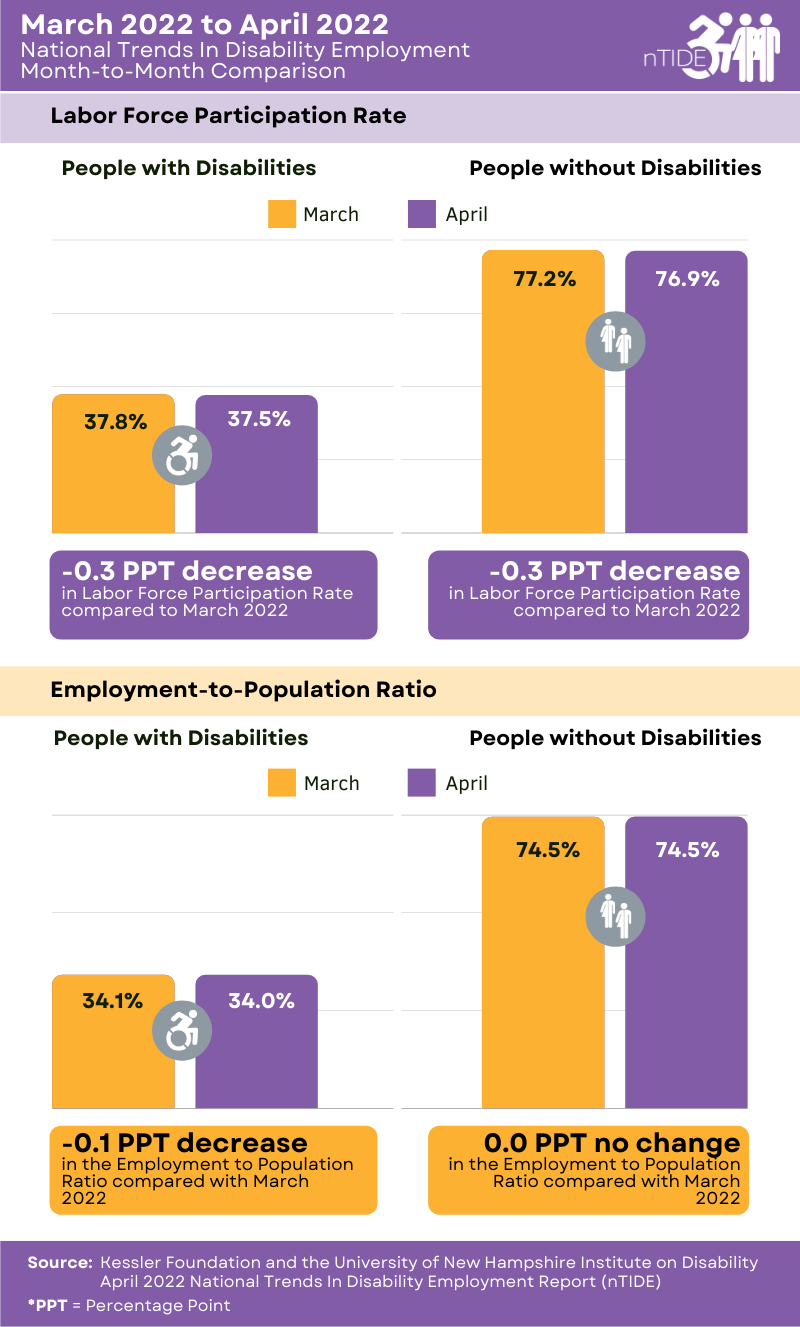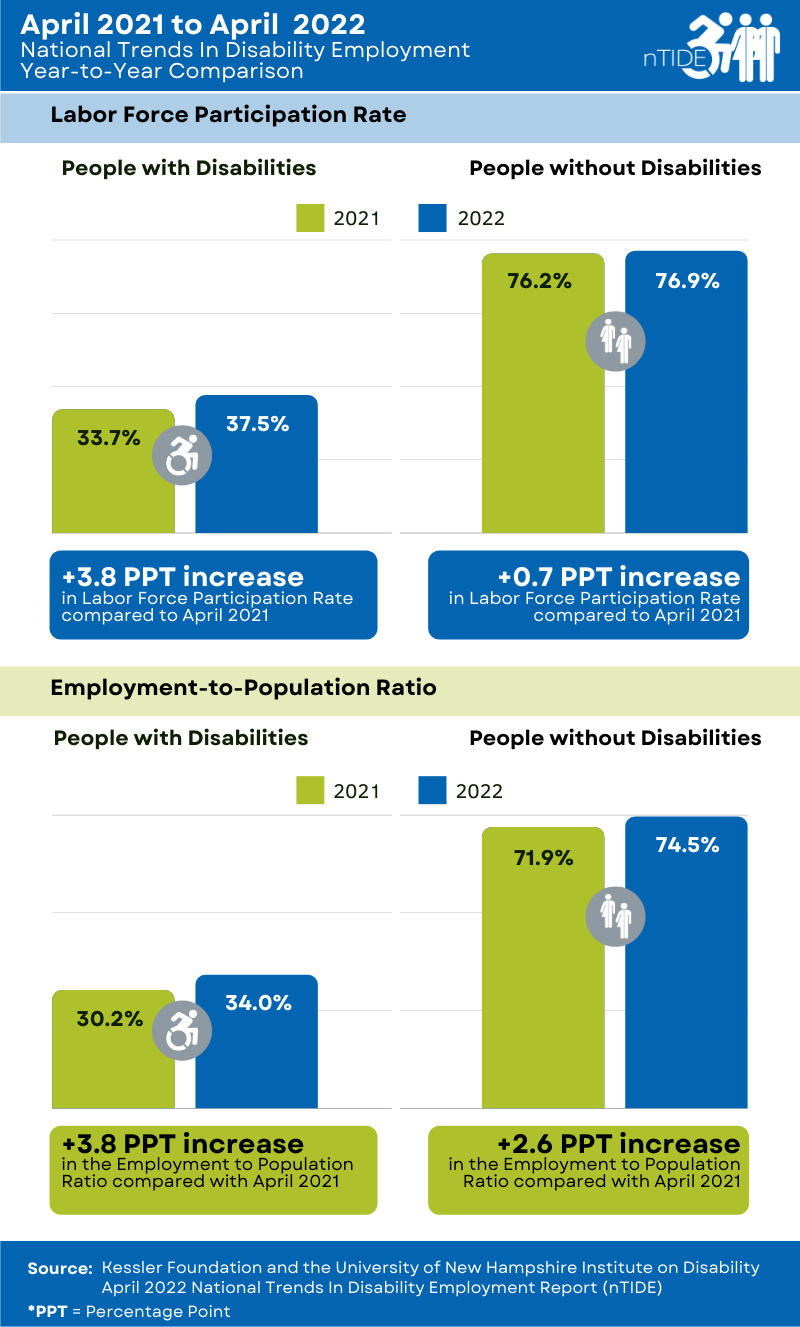National Trends in Disability Employment (nTIDE) – issued semi-monthly by Kessler Foundation and the University of New Hampshire
East Hanover, NJ – May 6, 2022 – The post-pandemic economic recovery of people with disabilities remained strong in April and continued at historic highs, according to today’s National Trends in Disability Employment – Monthly Update (nTIDE), issued by Kessler Foundation and the University of New Hampshire’s Institute on Disability (UNH-IOD). Looking ahead, nTIDE experts will watch closely for the potential impact of anti-inflation measures on the labor market.

employment-to-population ratio and the labor force participation rate for people with disabilities. For people
without disabilities, the employment-to-population ratio was unchanged, and the labor force participation rate
decreased slightly.
Month-to-Month nTIDE Numbers (comparing March to April)
In the US Bureau of Labor Statistics (BLS) Jobs Report released Friday, the employment-to-population ratio for working-age people with disabilities decreased slightly from 34.1 percent in March to 34.0 percent in April (down 0.3 percent or 0.1 percentage points). For working-age people without disabilities, the employment-to-population ratio stayed the same as in March at 74.5 percent. The employment-to-population ratio, a key indicator, reflects the percentage of people who are working relative to the total population (the number of people working divided by the number of people in the total population multiplied by 100).
Three major factors outweigh the small declines in April’s numbers, according to John O’Neill, PhD, director of the Center for Employment and Disability Research at Kessler Foundation. “First, employment remains steady in the face of economic uncertainty. Second, this month saw the seventh consecutive month where labor force participation was higher than the 2008 historic high. Finally, the employment-to-population ratio and labor force participation continue to exceed pre-pandemic levels. We have not seen such sustained good news since 2018, when people with disabilities emerged from the employment lows of the Great Recession.”
Findings were similar for April’s labor force participation rates. For working-age people with disabilities, the labor force participation rate decreased slightly, from 37.8 percent in March to 37.5 percent in April (down 0.8 percent or 0.3 percentage points). For working-age people without disabilities, the labor force participation rate also decreased slightly from 77.2 percent in March to 76.9 percent in April (down 0.4 percent or 0.3 percentage points). The labor force participation rate is the percentage of the population that is working, not working and on temporary layoff, or not working and actively looking for work.
“Overall, the post-lockdown economic recovery of people with disabilities remains relatively strong and, in fact, stronger than the economic recovery of people without disabilities,” remarked Andrew Houtenville, PhD, professor of economics and the research director of the University of New Hampshire’s Institute on Disability.
“Our data show that the Great Resignation is largely a phenomenon among workers without disabilities,” Dr. Houtenville added, “as we see people with disabilities remaining engaged in the labor market. In the coming months, we will be looking at how the Federal Reserve’s actions to combat inflation will affect the labor market and the job numbers.”

and without disabilities as the effects of the pandemic abate.
The employment-to-population ratio for working-age people with disabilities increased from 30.2 percent in April 2021 to 34 percent in April 2022 (up 12.6 percent or 3.8 percentage points). For working-age people without disabilities, the employment-to-population ratio also increased from 71.9 percent in April 2021 to 74.5 percent in April 2022 (up 3.6 percent or 2.6 percentage points).
The labor force participation rate for working-age people with disabilities increased from 33.7 percent in April 2021 to 37.5 percent in April 2022 (up 11.3 percent or 3.8 percentage points). For working-age people without disabilities, the labor force participation rate also increased from 76.2 percent in April 2021 to 76.9 percent in April 2022 (up 0.9 percent or 0.7 percentage points).
In April 2022, among workers ages 16-64, the 5,653,000 workers with disabilities represented 3.8 percent of the total 147,651,000 workers in the U.S.
Ask Questions about Disability and Employment
Each nTIDE release is followed by a nTIDE Lunch & Learn online webinar. This live broadcast, hosted via Zoom Webinar, offers attendees Q&A on the latest nTIDE findings, provides news and updates from the field, as well as invited panelists to discuss current disability-related findings and events. Today, May 6th, at 12:00 pm Eastern, Jim E. Warne, MS, director of Community Engagement and Diversity at the University of South Dakota Center for Disabilities, Oyate Circle at Sanford School of Medicine, joined Drs. Houtenville and O’Neill, and Denise Rozell, Policy Strategist at AUCD. Join our Lunch & Learns live or visit the nTIDE archives at: ResearchonDisability.org/nTIDE.
nTIDE COVID Update
Join us on May 20, at 12:00 pm Eastern for the mid-month COVID update - an in-depth comparison of the latest unemployment numbers for people with and without disabilities. Register at: COVID-19 Updates - 2022 | Center for Research on Disability.
NOTE: The statistics in the nTIDE are based on Bureau of Labor Statistics numbers but are not identical. They are customized by UNH to combine the statistics for men and women of working age (16 to 64). nTIDE is funded, in part, by grants from the National Institute on Disability, Independent Living and Rehabilitation Research (NIDILRR) (90RT5037) and Kessler Foundation.
About the Institute on Disability at the University of New Hampshire
The Institute on Disability (IOD) at the University of New Hampshire (UNH) was established in 1987 to provide a coherent university-based focus for the improvement of knowledge, policies, and practices related to the lives of persons with disabilities and their families. For information on the NIDILRR-funded Employment Policy and Measurement Rehabilitation Research and Training Center, visit ResearchOnDisability.org.
About Kessler Foundation
Kessler Foundation, a major nonprofit organization in the field of disability, is a global leader in rehabilitation research that seeks to improve cognition, mobility, and long-term outcomes -- including employment -- for people with neurological disabilities caused by diseases and injuries of the brain and
spinal cord. Kessler Foundation leads the nation in funding innovative programs that expand opportunities for employment for people with disabilities.